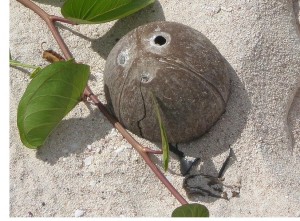SATURDAY, 2 JULY 2011
 The coconut palm (Cocos nucifera) has long been an important source of food, water, oil, and construction materials for people throughout the tropics. Many researchers have speculated on the origins and history of human coconut cultivation, largely basing their analyses on morphological and archaeological evidence.
The coconut palm (Cocos nucifera) has long been an important source of food, water, oil, and construction materials for people throughout the tropics. Many researchers have speculated on the origins and history of human coconut cultivation, largely basing their analyses on morphological and archaeological evidence.Kenneth Olsen and colleagues set out to clarify the origins of the coconut using genetic data [1]. They took samples from trees in Madagascar, the Comoros and the Seychelles, and combined their specimens with samples from a French collection. For each sample, genetic markers were analysed and clearly showed that there are two distinct coconut populations, arising in the Pacific Ocean and Indian Ocean. This is surprising given the extent of human travel and activity in recent eras, which might be expected to have increased their rate of genetic mixing. Olsen suggests that the two coconut populations were established many years ago, long before human influence, and only later began to be cultivated by man, in two separate locations.
Interestingly, a few samples do not fit neatly into either the Pacific or Indian Ocean groups; coconuts from the south-western Indian Ocean show a mixture of both genetic markers. Olsen believes that Austronesian peoples using an ancient trading route around 1500 years ago may have introduced Pacific coconuts to this region from South-East Asia [2].
Written by Emma Hatton-Ellis
